Top 20
Top 20 National Parks in India: Visit For Memorable The Tour
In India, there are a total of 106 national parks and all of these national parks combined cover more than 2% of the country’s total geographical area. In addition to this, plans are being made by the government to establish more national parks in the country and expand the flora and fauna diversity, and also to safeguard the wildlife habitats that are being endangered and nearing extinction.
National parks, zoos, and wildlife sanctuaries are frequented by both children and adults from every corner of the world. These are also the places that even local, national, and foreign tourists visit and find captivating. There are diverse species of birds and animals, and all are kept in a well-protected habitat.
Did You Know?
The first national park to have been opened in India was the Jim Corbett National Park in the state of Uttarakhand (formerly Uttaranchal). It was established in 1936 and is located in the Nainital district. However, it is said that the oldest national park to have been established in India is the Kaziranga National Park in Assam, which can be dated back to the year 1906.
Anyway, over the years, more of these wildlife habitats were established in different regions throughout the country’s territories and which are open for the public to visit and enjoy the wildlife sight-seeing.
At least once in our lifetime, each one of us may have visited a national park, a wildlife sanctuary, a city zoo, or even a botanical zoo, which is home to several species of plants and trees. And, if you’re planning to go on exploration, these national parks should also be included in your checklist this summer or winter.
Here, we’re going to take a look at twenty such national parks in India that are known widely for their habitat, consisting of diverse flora and fauna species.
20 Popular National Parks in India that Make for a Perfect Tourist Destination
The following is a non-exhaustive list (in alphabetical order) of popular national parks in India you can visit during your holidays with friends, family, and relatives.
1. Bandhavgarh National Park
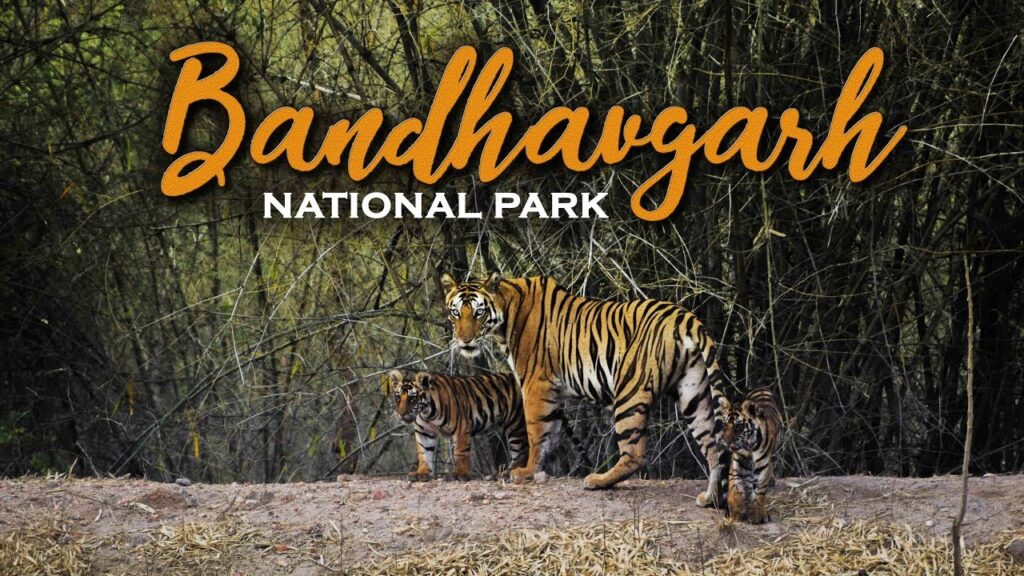
Location: Umaria, Madhya Pradesh
Right Time to Visit: November – February, and March – June
Advisory: The national park remains closed from July to October.
The Bandhavgarh National Park is a popular national park located in the Umaria district of the state of Madhya Pradesh. It is also well-known for being a natural habitat of the royal Bengal tiger species. It spreads from the Vindhya hills with steep ridges, undulating, forest, and open meadows. Bandhavgarh gets its name from the ancient Bandhavgarh Fort – ‘Bandhav’ (meaning brother) and ‘Garh’ (meaning fort). The ancient Bandhavgarh Fort is having very great importance as it is believed that it was gifted by Lord Rama to his younger brother Lakshmana to keep a watch on the Lanka.
The national park is situated about 463 km (287.70 miles) from the capital city of Bhopal and a road trip can take a little over 9 hours.
Bandhavgarh National Park is home to 37 species of mammals, 250 species of birds, 80 species of butterflies, and more. It has a history of being the major dwelling place for white tigers. In addition to tigers, there are other wildlife species, which include Sambar deer, barking deer, chinkara, nilgai, striped hyena, elephant, chital, langur, caracal, Indian wolf, gaur, Indian bison, etc.
Bandhavgarh National Park is the first in India to launch ‘The Hot Air Balloon Safari’ for tourists. An aerial view of the restricted buffer zone and the core zone will be an exclusive experience for safari lovers. Jeep safari rides are available in four zones namely, the Tala zone, Magadhi zone, Khitauli zone, and Panpatha zone.
2. Dudhwa National Park
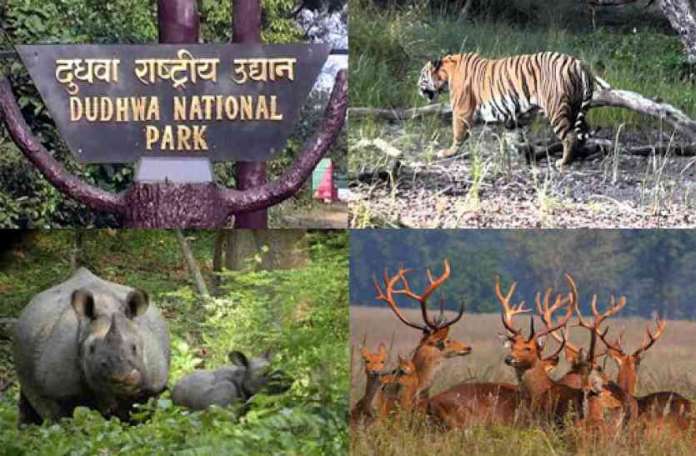
Location: Terai, Uttar Pradesh
Right Time to Visit: November – June
Advisory: Accommodation inside the national park is available on request.
The Dudhwa National Park, also called the Dudhwa Tiger Reserve, is located in the areas of the Lakhimpur and Kheri districts in the state of Uttar Pradesh. It lies adjacent to the Indo-Nepal border, bringing together the two most incredible sanctuaries of the area namely, Kishanpur and Katerniaghat Wildlife Sanctuaries, to represent the excellent natural forests and greenery along the Terai region. The journey by road from the capital city of Lucknow to the Dudhwa National Park is about 228 km (141.68 miles) which can take more than 5 hours.
The area of the Park is made up of a vast alluvial plain along the tributaries of Mohana and Suheli, interspersed with numerous rivulets, lakes, and pools. The rich and extremely fertile Indo-Gangetic plains support a flamboyant growth of the forest’s diversity of fauna. The park has some of the best forests of ‘Sal’ trees in the world, amongst other flora, and is a virtual unexplored paradise for nature lovers, wildlife enthusiasts, and bird watchers. It is one the most ideal and protected homes for more than 38 species of mammals, 16 species of reptiles, and numerous species of birds.
The rhinoceroses kept here were relocated from Assam and Nepal to rehabilitate their population in the national park. Wildlife watching here includes spotting species of tiger, rhinoceros, swamp deer, elephant, Sambar deer, hog deer, cheetah, Kakar, wild boar, Rhesus monkey, langur, sloth bear, blue bull, porcupine, otter, turtle, python, monitor lizard, mugger, gharial, etc.
3. Gir National Park
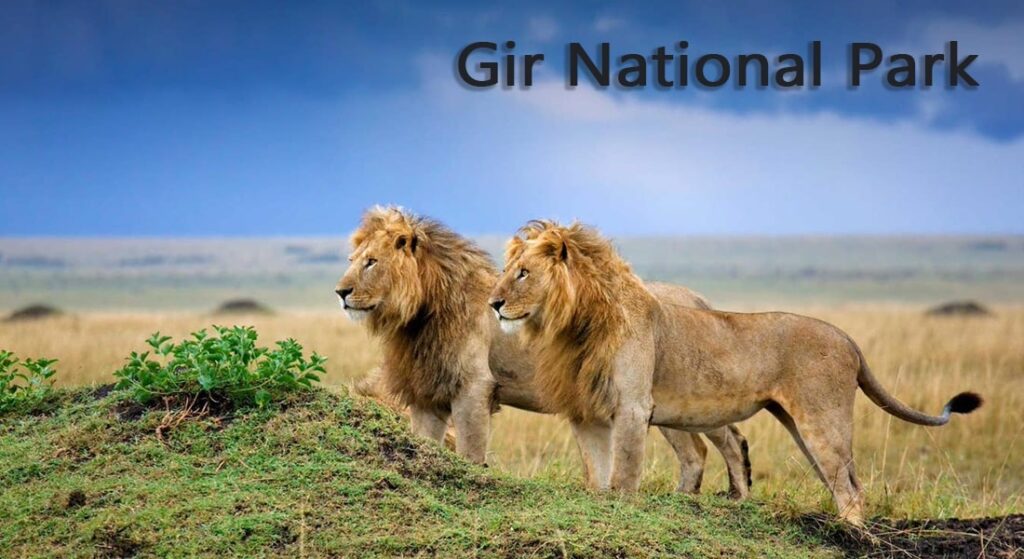
Location: Talala Gir, Gujarat
Right Time to Visit: April – May, and December – March
Advisory: The national park remains closed from June to October every year.
Gir National Park is a popular national park in India that was established in 1965. It is also called the Gir National Park and Wildlife Sanctuary, and Sasan Gir. It is located about 379 km (235 miles) from the capital city of Gujarat, and the journey by road can take up to 7 hours or more.
It is said that prior to its establishment as a national park and a wildlife sanctuary, the forest region used to be a private hunting ground for the Nawab of Junagarh in the 19th century.
The Gir National Park is a major habitat for lions, and their population is protected by government authorities in order to prevent the decline of the species. There are about 75 species of animals, 300 species of birds, and 2,000 species of insects in the national park. The common fauna species which you can see here are lion, leopard, hyena, jackal, fox, mongoose, four-horned antelope, tortoise, wild boar, black-buck, cobra, monitor lizard, crocodile, etc. Also, there are about 400 species of trees and plants, including banyan, teak, etc.
4. Great Himalayan National Park

Location: Kullu, Himachal Pradesh
Right Time to Visit: March-May and June – November
Advisory: Some areas may be inaccessible in winter due to snow and harsh weather conditions.
The Great Himalayan National Park is a popular national park which is situated in the Kullu district in the state of Himachal Pradesh. From the capital city of Shimla, the national park is located at a distance of about 146 km (90.7 miles), and the road trip can take a little over 3 hours.
Here, you will find diverse species of animals, birds, insects, plants, and trees. These include about 553 species of animals and insects combined and more than 180 bird species. Some common species of animals which can be seen here are musk deer, mountain goat, snow leopard, Himalayan brown bear, Himalayan tahr, etc. The national park was established in the year 1984 and is now a World Heritage Site that is protected by UNESCO since 2014.
The Great Himalayan National Park is spread over four valleys. Each of which offers a very wide variety of endemic and exotic flora and fauna. These valleys include the Tirthan Valley, Sainj Valley, Jiwa Nal Valley, and the Parvati Valley. These valleys and the areas surrounding the national park in the Himalayan mountain ranges are also very popular trek routes among adventurers.
5. Hemis National Park
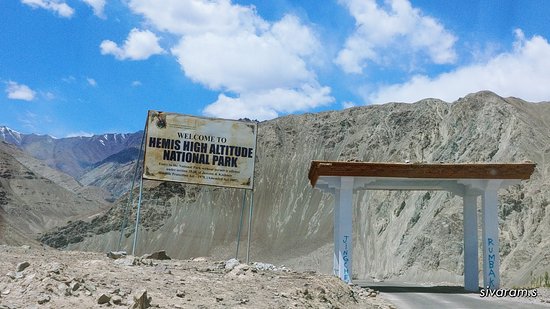
Location: Leh, Ladakh
Right Time to Visit: May – September
Advisory: Road to the national park is rough and there are four check-posts that regulate access to vehicles within the park’s boundaries.
Hemis National Park is the only national park in the Indian state of Ladak. It was established in 1981 and has been expanding in the area since. The park is also home to the local inhabitants that live in the nearby areas with their livestock. A road trip to the national park from Leh is about 50 km (31.4 miles) that’s about 2 hours.
The national park is a natural habitat for a variety of animals, birds, plants, and tree species. You will find wildlife, which includes the blue sheep (or Bharal), the Great Tibetan Sheep (Argali), Shapu, Asiatic ibex, Tibetan wolf, red fox, Eurasian brown bear, the Himalayan mouse hare, the Himalayan marmot, etc.
In addition to wildlife spotting, the Hemis National Park also has trek routes for adventurers. The park also has the Hemis Monastery (Tibetan monasteries are also called gompas), Stok Kangri (the highest peak), the Ganda La Winter Pass (on the way to Skiu village), and a lot more captivating landscapes and villages.
6. Jim Corbett National Park
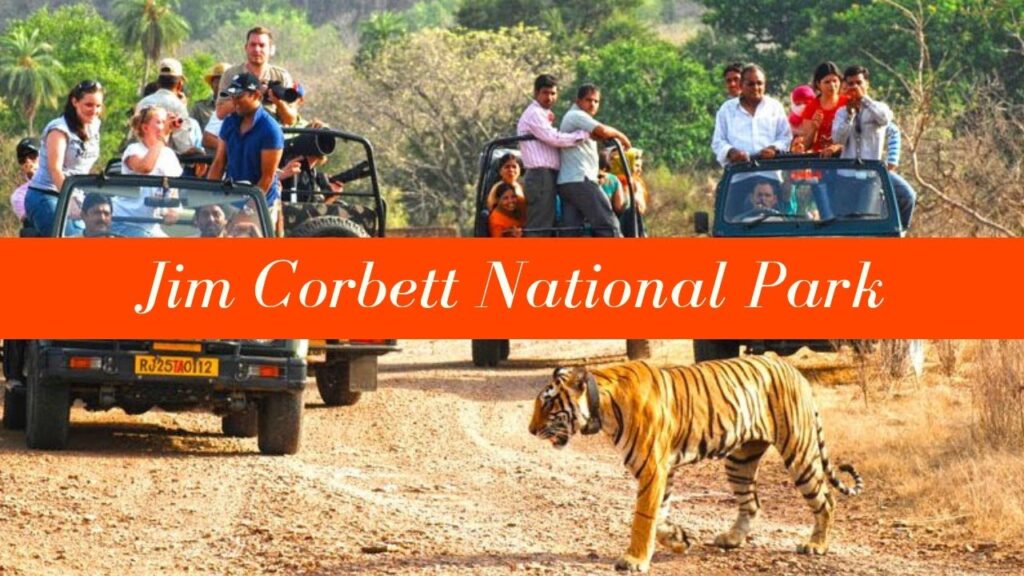
Location: Nainital, Uttarakhand
Right Time to Visit: April – June, and November – January
Advisory: Camping can be dangerous and special permission may be required.
Jim Corbett National Park is one of the oldest and very famous national parks in India. It was opened in 1936 in the Nainital district of Uttarakhand, which is 178 kilometers (107.6 miles) from the capital city of Dehradun. That’s about a 3-hour journey by road from the city. It is also interchangeably called the Corbett Tiger Reserve, so do not be confused.
Jim Corbett National Park is named after Jim Corbett, a British-national naturalist and hunter who lived in India and died a year before having the wildlife habitat named in his memory and for his work. It is said that the national park was first called Hailey National Park, named after the Governor, William Malcolm Hailey, in its early years of establishment, but was changed to what is known to us today.
Aside from its history, the Jim Corbett National Park is home to several species of animals and birds and is covered by forests spanning a few kilometers in area. There are about 75 species of animals, 580 species of birds, and over a hundred species of trees that grow here, including mango trees, peepal, sal, Rohini, haldu, etc. A few animal species include tigers, elephants, deer, buffaloes, leopards, langurs, crocodiles, gharials, python, etc.
The national park gained popularity when it was filmed for a scene in the Bollywood movie ‘Kaal (2005)’ and also for the ‘Man vs Wild’ show on Discover Channel, featuring India’s present prime minister Narendra Modi with host Bear Grylls, which was aired in 2019.
7. Kalesar National Park

Location: Yamunanagar district, Haryana
Right Time to Visit: March To June & October To December
Advisory: The national park remains closed from July to September.
The Kalesar National Park is a popular national park and wildlife sanctuary located in the Yamunanagar district of the state of Haryana. It shares its boundaries with the Rajaji National Park in Uttarakhand, the Simbalbara National Park in Himachal Pradesh, and the state of Uttar Pradesh. The Park is named after the name of The Kalesar (shiva) temple located in the protected area.
There are many wildlife species to watch here, including leopard, panther, elephant, ghoral, barking deer, Sambar deer, chital, grey langur, rhesus macaque, Indian crested porcupine, red jungle fowl, python, King cobra, monitor lizard, etc.
Safari is also available on three routes for exploring the national park and wildlife watching. Each route is almost 7 km (4.5 miles).
8. Kanha National Park

Location: Mandla, Madhya Pradesh
Right Time to Visit: October To June
Advisory: The park is closed from July to September.
Kanha National Park is spread across the Maikal range in the state of Madhya Pradesh. In the year 1955, Kanha National Park was declared a national park. This makes a total of 11 national parks in Madhya Pradesh alone, and the most number in all of India. It is located about 56 km (34.8 miles) from Mandla, which is just over 1 hour trip by road.
The Kanha National Park is home to many species of wildlife, from tigers to the barasingha, and countless other species of reptiles birds, insects, plants, and trees. It has a significant amount of population of royal Bengal tigers. Safari and day and night trekking are available to explore more here.
The reserve has fascinated many travelers around the corners of the world. One of the best locations where you can enjoy the most is the Bammi Dadar, which is also known as The Sunset Point. Not only Kanha even the nearby destinations next to Kanha, like the Shravan Tal, Sindoor Trees, Bandhavgarh, Pench Sanctuary, Lapsi Kabar, Kanha Meadows, Kanha Museum, etc., are the magnificent locations for the wildlife and nature lovers.
9. Kaziranga National Park

Location: Between Golaghat and Nagaon districts, Assam
Right Time to Visit: March To May & November To February
Advisory: Avoid visiting in monsoon season (i.e., June – September), due to excessive flooding in the region on rainy days.
Kaziranga National Park is one of the most popular national parks in India and also, being the oldest in the country. It is located between the Golaghat and Nagaon districts of the state of Assam and is known all over the world for its one-horned rhinoceros habitat. Previously, it was called the Kaziranga Game Sanctuary, then renamed Kaziranga Wildlife Sanctuary, and renamed again to what is called today. The national park is also declared a World Heritage Site by UNESCO in 1985. From the capital city of Guwahati to Kaziranga National Park, the distance by road is about 193 km (119 miles), and the journey can take up to 4 hours or more.
Looking back at the establishment of this wildlife sanctuary in India, it came into being in the year 1905 as a protected reserve forest by Lord Curzon of Kedleston, the then Viceroy of India, and the credit goes to his wife, Mary Curzon, who initiated the project to protect the rhinoceros species. It was thus, the year 1968 when the Government of India declared the reserve as a wildlife sanctuary and also to protect the flora and fauna in the region. Its landscape is situated in close proximity to the mighty Brahmaputra river.
The national park often comes in the news for cases, like floods and poaching of rhinoceroses. Nonetheless, visiting the Kaziranga National Park, especially to see the one-horned rhinoceroses will amaze every local, national and foreign tourist. Aside from the rhinoceros species, there are also diverse species of Sambar deer, elephant, buffalo, Bengal tiger, jackal, flying squirrel, leopard, pangolin, langur, mongoose, python, monitor lizard, etc., and numerous bird species.
10. Mollem National Park

Location: Molem, Goa
Right Time to Visit: January – March, and October – December
Advisory: For hiking and trekking activities, prefer taking a guide along as some trails are unmarked.
Mollem National Park is a wildlife sanctuary located in the state of Goa. It is popularly referred to as the Bhagwan Mahavir Sanctuary and Mollem National Park and was altogether established in 1978. During its first establishment, the reserve was called Mollem Game Sanctuary but was declared a wildlife sanctuary in 1969. From the capital city of Panaji to Mollem National Park the distance is about 58 km (36 miles), and the journey by road takes just a little over 1 hour.
The name of Mollem National Park comes from the name of the Mollem village situated in the Dharbandora district, which is less than 2 hours away from the capital city. Also, the name Bhagwan Mahavir Sanctuary could be the name given to it by the Mahadev Temple (Tambdi Surla Temple), which is a popular attraction in the area. The temple is believed to have been built in the 12th century during the Kadamba Dynasty and earlier.
The Bhagwan Mahavir Sanctuary and Mollem National Park is a habitat for several species of animals, birds, plants, and trees along with other attractions, such as the Dudhsagar Falls, and Tambdi Falls, Devil’s Canyon, etc. You will find many animal species, including Bengal tiger, leopard, macaque, deer, flying squirrel, pangolin, Malabar giant squirrel, monkey, wild boar, python, pit viper, King cobra, common krait, etc. Also, there are many species of birds as well as butterflies.
11. Mudumalai National Park

Location: Gudalur, Tamil Nadu
Right Time to Visit: February To May & September To October
Advisory: The monsoon months of July – August may not be ideal, even for trekking. Forest houses inside the national park are provided on a first come first serve basis. You will need to book in advance by calling the Ooty office of the National Park.
The Mudumalai National Park is situated in the Nilgiri district on the borders of the states of Tamil Nadu and Karnataka. The national park can also be accessed from the cities of Ooty and Mysore, being the nearest. It is famous for its tiger population and thus, is also called the Mudumalai Tiger Reserve. From the capital city of Chennai, it is located about 579 km (359.77 miles), which can take over 9 hours.
It is surrounded by the Bandipur National Park and Nagarhole National Park to the north and the Wayand wildlife sanctuary to the south. It is a natural habitat for more than 500 species of animals, birds, reptiles, and insects. Here you can spot wildlife species, including the Bengal tiger, elephant, leopard, flying lizard, the Indian Giant Squirrel, Grey Langur, Golden jackal, striped hyena, Indian Rock Python, cobra, pit viper, etc.
It also connects the Eastern Ghats and the Western Ghats. The Moyar River runs through the reserve. Common activities here include jungle safari, elephant safari, elephant camps, trekking, wildlife watching, etc.
12. Sultanpur National Park
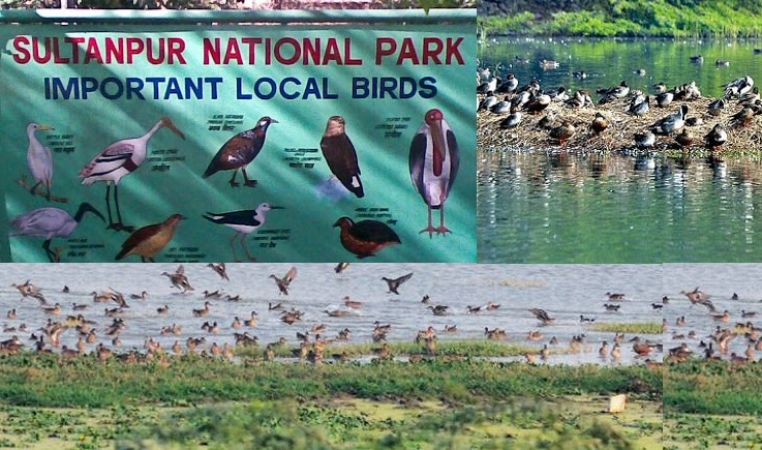
Location: Sultanpur village, Haryana
Right Time to Visit: December To February
Advisory: For those wishing to stay overnight, the national park provides accommodation with all amenities.
The Sultanpur National Park used to previously be called the Sultanpur Bird Sanctuary. It was developed into a national park in 1991. The national park is located on the Gurugram-Farukhnagar road in Sultanpur village, which is about 15 km (9.3 miles) from the capital city of Gurugram.
Sultanpur National Park is originally a bird watcher’s paradise with few trees obscuring the visitor’s view of the lake. The birds in ‘Sultanpur National Park’ can be easily spotted doing wading, swimming, or flying. To facilitate bird watching, there are four watch towers (locally referred to as ‘machans’) that are located at different points.
For the tourists who are visiting the Sultanpur National Park, The Educational Interpretation Centre has been established there to offer proper guidance to them. The Tourist Complex built in the Park has elegant rooms equipped with all modern facilities, a restaurant, and a bar. The national park is also a popular picnic spot for residents of New Delhi and the NCR (National Capital Region) and watches a variety of bird species migrate here during winter.
13. Periyar National Park
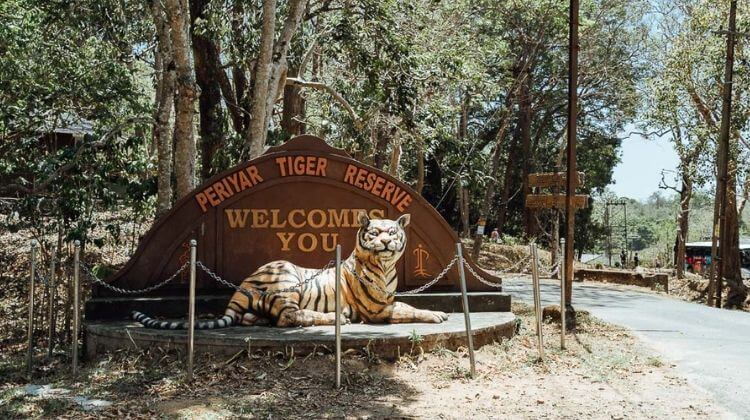
Location: Kottayam, Kerala
Right Time to Visit: September To April
Advisory: Many areas inside the park are restricted during monsoon season.
Periyar National Park is a popular national park, wildlife sanctuary, and tiger reserve in the state of Kerala. It was opened in the year 1982. It is named after the river Periyar, which is the longest perennial river that is also a source of drinking water for the nearby towns and settlements. The national park is located about 100 km (62 miles) from the city of Kottayam and 255 km (158 miles) from the capital city of Thiruvananthapuram.
The Periyar National Park is a natural habitat for wildlife and flora species. There’s also the Periyar Lake (artificial reservoir), the Pachayarmala, Vellimala, Sunderamala, Chokkampetti mala and Karimala peaks, Cardamom Hills, and more.
Safari is also available to explore the national park and its wildlife. Other fun-filled activities include trekking (day and night), camping, tiger trail, and bamboo rafting. You can also enjoy their tribal dance performance.
14. Ranthambore National Park
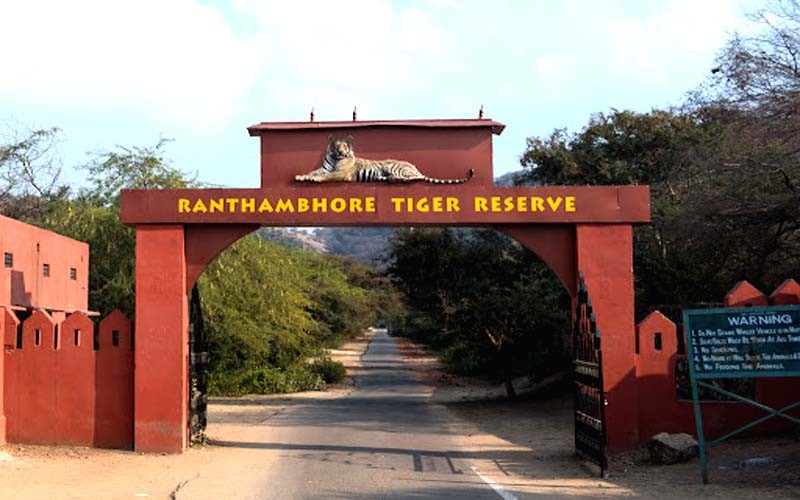
Location: Sawai Madhopur, Rajasthan
Right Time to Visit: October To June
Advisory: The national park is closed from July to September.
Ranthambore National Park is also called the Ranthambore Tiger Reserve and is very popular among wildlife lovers for its diurnal tigers and national park safari. It is located about 10 km (6.36 miles) from the Sawai Madhopur town and 160 km (99.42 miles) from the capital city of Jaipur.
The national park was opened in 1980 and is currently a habitat for diverse species of wildlife and flora. The Bengal tiger is the main attraction here, and for that, it’s called the Ranthambore Tiger Reserve. You will find about 40 species of mammals, 320 species of birds, 40 species of reptiles, 50 species of butterflies, and 300 species of plants at the Ranthambore National Park.
Other than the wildlife habitat, the national park offers more attractions within its vicinity, such as the Ranthambore Fort, Padam Talao, Aravali Range, Jogi Mahal, and many more. India’s second largest banyan tree can also be found here. Both jeep safari (20 seaters) and canter safari (6 seaters) are available to take you around the national park for wildlife spotting.
15. Sariska National Park
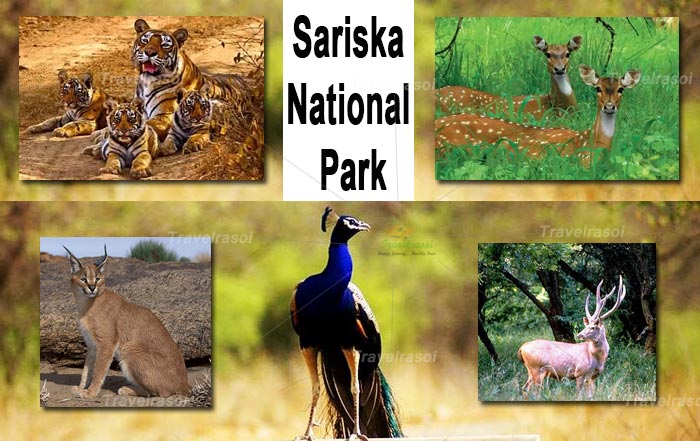
Location: Alwar district, Rajasthan
Right Time to Visit: October To May
Advisory: The national park remains closed from July till September.
Sariska National Park, also called Sariska Tiger Reserve, is situated in the Aravali Hills of the Aravali Range and is covered by grasslands, dry deciduous forests, sheer cliffs, and rocky landscapes. It is about 107 km (65 miles) from the capital city of Jaipur.
The sanctuary is a natural habitat for diverse wildlife species. Here, you can spot a variety of wild animal species, like tiger, leopard, sambhar, chital, nilgai, four-horned antelope, wild boar, rhesus macaque, langur, hyena, and jungle cat. There is no doubt in saying that it is home to India’s largest population of peafowl and harbours quail, sand grouse, golden-backed woodpeckers, and crested serpent eagles, among other species. Also, on the Siliserh Lake on the edge of the park, there are a large number of crocodiles.
The Sariska Wildlife Sanctuary also houses the ruins of medieval temples of Garh-Rajor that dates back to the 10th and 11th centuries. There is the Kankwadi Fort on the hilltop that was built in the 16th century and provides a panoramic view of flying vultures and eagles. In 1955, it was declared a sanctuary and also gets the status of a National Park in 1979.
16. Silent Valley National Park
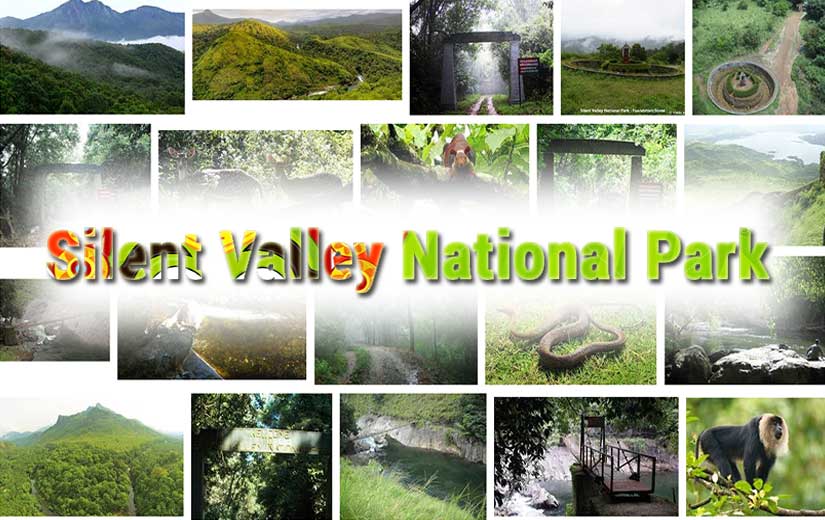
Location: Mannarkkad, Kerala
Right Time to Visit: December To April
Advisory: The national park remains closed on Fridays.
Silent Valley National Park is a vast area covered mainly by rainforests and gives you a clear view of the Nilgiri Hills, which is another popular attraction in Kerala. Declared as a national park in the year 1984, the Silent Valley reserve is situated in the Palakkad district, which is about 401 km (249.17 miles) from the capital city of Thiruvananthapuram. The journey by road can take a little over 8 hours.
The national park is a natural habitat for a wide species of wildlife, flora, and fauna. The animal species include tigers, leopards, elephants, snakes, Lion-Tailed Macaques, Malabar Giant Squirrels, moths, bugs, toads, and plenty more. There are more than 1,000 species of flowering plants and another 110 species of orchids.
Additionally, there are other attractions, like the Nilgiri plateau, the ancient Kunthi river, and Sairandhri, which is a two-hour jeep safari ride from the nearest town of Mukkali to experience the area, and more.
17. Sundarbans National Park
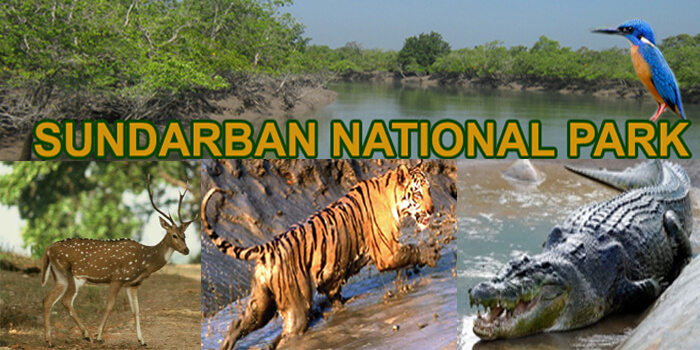
Location: South 24 Parganas district, West Bengal
Right Time to Visit: October To March
Advisory: Monsoon season is not ideal to visit the Sundarbans National Park as the area may be affected by storms and cyclones. Also, visitors and tourists are advised to take precautions against the presence of man-eating tigers.
The Sundarbans National Park is one of the most popular wildlife reserves situated in the Indian state of West Bengal and borders the neighboring country, Bangladesh. It is also popular for its delta, marshland, mangrove trees, salt water, royal Bengal tigers, and more. The reserve was declared a national park in the year 1984.
The national park is located in the South 24 Parganas district, which is about 160 km (81 miles) from the capital city of Kolkata.
The entire region surrounding the Sundarbans National Park is a natural habitat for diverse species of animals, migratory birds, and flora. Most endangered wildlife species are protected in the reserve. There is a boat safari available to tourists to explore and enjoy the national park and its wildlife spotting.
18. Tadoba National Park

Location: Chandrapur district, Maharashtra
Right Time to Visit: October To June
Advisory: The national park remains closed from July to September due to the monsoon season which makes the Tiger Reserve inaccessible.
The Tadoba National Park is the oldest and largest national park in the state of Maharashtra. The national park is also called in the region as the Tadoba-Andhari Tiger Reserve. The word ‘Tadoba’ attain from the name of God “Tadoba” or “Taru,” which is praised by local tribal people of this region and “Andhari” gets from the name of the Andhari river that flows in that area.
A major part of this forest lies in the hilly area, thus many hillocks and terrains provide shelter to the wild animals here. It has a dense forest area, smooth meadows, deep valleys, and a great atmosphere to preserve more numbers of tigers. A few lakes make sure the park has rich water resources. Teak is one of the most prominent tree species in the forest.
The main attraction of the Tadoba National Park is the Jungle or Tiger Safari in an open-top gypsy. There is a good chance to spot the shy Sloth Bear and Wild Dogs and one can also find some of Central India’s best native woodland bird species in this forest.
19. Valmiki National Park

Location: West Champaran District, Bihar
Right Time to Visit: November To March
Advisory: VTR is open from October till May only.
Valmiki National Park is both a Wildlife Sanctuary and a Tiger Reserve, and thus, is also called the Valmiki Tiger Reserve (VTR) interchangeably in the state of Bihar. It is located about 275 km (170.8 miles) from the capital city of Patna, and the journey by road can take up to 7 hours or more.
The northern area of the Valmiki Tiger Reserve lies in close proximity to the borders of the Chitwan National Park, which is located in the neighboring country of Nepal.
By its name, VTR is a major habitat for the Bengal tiger species, although you will find several more species of animals and birds here. A few animal species that are kept here include elephant, rhinoceros, striped hyena, leopard, clouded leopard, langur, monkey, Indian gaur, black bear, sloth bear, spotted and Sambar deer, python, King cobra, monitor lizard, crocodile, gharial, etc. Also, there are about 241 species of birds in the national park.
20. Van Vihar National Park

Location: Bhopal, Madhya Pradesh
Right Time to Visit: July To September
Advisory: The national park is closed on Fridays.
The Indian state of Madhya Pradesh is home to 11 national parks, being the highest in the country. Among these, the Van Vihar National Park which was opened in 1981, is located in the capital city of Bhopal. A road trip from Bhopal city to the Van Vihar National Park is about 6.49 km (4.03 miles), which takes less than 30 minutes.
The species of animals kept here include tiger, lion, panther, wolf, red fox, sloth bear, hare, hyena, mongoose, jackal, crocodile, blackbuck, langur, Chital, python, cobra, viper, etc. You can also watch a variety of bird species here, including migratory birds.
The national park provides bicycles for rent at the entrance gates in order to promote cycling in the park.
Conclusion
Although some national parks may be suitable to visit during a preferred season, there are also a few that could be visited any time of the year. Those who love adventures, treks, and traveling, will surely find these popular national parks and wildlife sanctuaries worth the visit and something to create memories and cherish for years.
Just a closing word – it is heartbreaking to learn that many tourist places (as well as public places) not only in India but all over the world are being polluted by human waste, which can have a negative impact on the landscapes, habitats, climate and the ecosystem as a whole. Therefore, if everyone takes proper care and respects nature and its habitats, the world can definitely be a beautiful place to live in.

















